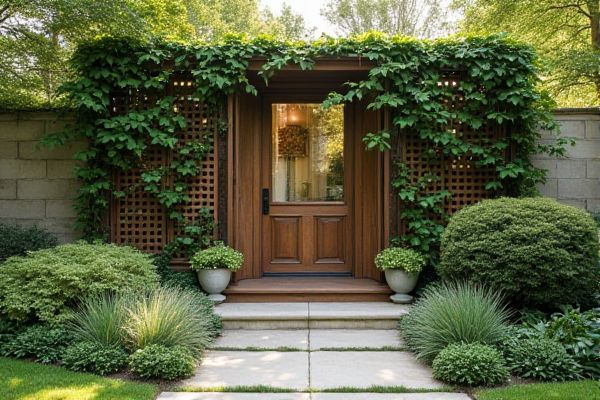
Choosing between a climbing trellis and a privacy lattice wall depends on your garden's needs for plant support versus screening; climbing trellises offer vertical growth for vines, while privacy lattice walls provide a more solid barrier for seclusion. Explore this article to discover which option best suits your outdoor space and gardening goals.
Table of Comparison
| Feature | Climbing Trellis | Privacy Lattice Wall |
|---|---|---|
| Purpose | Supports climbing plants, decorative | Provides privacy and partial shading |
| Material | Wood, metal, or plastic frames | Wood or vinyl panels with lattice patterns |
| Design | Open grid for plant growth | Denser lattice for screening |
| Height | Usually 4-6 feet | Often 6-8 feet or higher |
| Installation | Wall-mounted or freestanding | Typically freestanding or fence attached |
| Privacy | Minimal privacy, mainly decorative | High privacy with partial light passage |
| Maintenance | Requires plant care and frame upkeep | Routine cleaning and possible repainting |
| Cost | Generally low to moderate | Moderate to higher depending on materials |
Introduction: Climbing Trellis vs. Privacy Lattice Wall
Climbing trellises are designed to support vertical growth of vines and plants, enhancing garden aesthetics and maximizing space, while privacy lattice walls provide a solid structural barrier that ensures seclusion and noise reduction. Trellises typically feature open frameworks ideal for lightweight climbers such as clematis and morning glory, whereas privacy lattice walls use denser patterns and sturdier materials like wood or vinyl to create effective visual shields. Selecting between a climbing trellis and a privacy lattice wall depends on the desired balance of plant integration versus privacy needs in outdoor spaces.
Purpose and Functionality Comparison
Climbing trellises serve primarily as support structures for climbing plants, enhancing vertical growth without blocking views, while privacy lattice walls focus on creating visual barriers to ensure seclusion in outdoor spaces. Both structures improve garden aesthetics, but privacy lattice walls provide greater coverage and protection against wind and noise. Choosing between them depends on whether your priority is maximizing plant growth or enhancing privacy.
Design Aesthetics and Visual Appeal
Climbing trellises offer a delicate, vertical framework that enhances garden spaces with a natural, airy appearance as plants weave through their open structure. Privacy lattice walls provide a solid, geometric pattern that balances concealment with decorative style, often integrating dense foliage for a lush, textured facade. Both designs elevate outdoor aesthetics but differ in visual impact, with climbing trellises promoting lightness and growth, while lattice walls emphasize structured elegance and seclusion.
Plant Growth Support Capabilities
A climbing trellis offers robust plant growth support by providing vertical structure tailored for vining plants, enabling healthier and more efficient upward growth. Privacy lattice walls also support plant growth but focus on creating a shaded environment that encourages denser foliage, enhancing screening effects. Your choice depends on whether you prioritize maximizing plant verticality or achieving a fuller privacy screen.
Privacy and Screening Effectiveness
Climbing trellises provide partial privacy by supporting vertical plant growth that creates a natural screen but often leaves gaps, reducing overall screening effectiveness. Privacy lattice walls offer denser coverage with interwoven panels specifically designed to block sightlines, ensuring more consistent and reliable privacy. For optimal screening, lattice walls combined with fast-growing climbers enhance both visual obstruction and aesthetic appeal.
Material Choices and Durability
Climbing trellises are often made from lightweight materials like wood, metal, or vinyl, offering moderate durability suitable for supporting vines without heavy exposure stress. Privacy lattice walls typically feature sturdier materials such as treated wood or composite panels designed to withstand weather elements while providing long-lasting privacy screens. Your choice between these options should consider the balance between material strength, maintenance needs, and the desired lifespan of your garden structure.
Installation Requirements and Ease
Climbing trellises typically require secure mounting on walls or sturdy posts, with installation involving anchoring points that support vertical plant growth while allowing airflow. Privacy lattice walls are often freestanding or attached to fences, demanding a more robust frame and precise alignment for both stability and effective screening. Trellises generally offer quicker, simpler installation, whereas lattice walls require more time and materials due to their structural complexity and larger size.
Maintenance and Longevity
Climbing trellises require minimal maintenance, often just occasional pruning to keep plants healthy and prevent overgrowth, which helps extend their lifespan. Privacy lattice walls, typically made from wood or vinyl, need regular upkeep such as painting or sealing to prevent weather damage and prolong durability. Choosing the right structure for your garden influences how much time and effort you invest in maintenance to ensure long-lasting results.
Cost Considerations and Budgeting
Climbing trellises are generally more cost-effective due to their simpler design and lighter materials, making them suitable for budget-conscious projects. Privacy lattice walls often require sturdier construction and durable materials, increasing both initial expenses and long-term maintenance costs. Your budget should account for these differences to ensure the chosen option aligns with your financial plan and desired durability.
Best Uses and Ideal Applications
Climbing trellises are best suited for supporting climbing plants like vines, roses, or vegetables, making them ideal for gardens and patios where vertical gardening or decorative greenery is desired. Privacy lattice walls provide structured screening to block views and enhance outdoor privacy, perfect for fences, balconies, or pool areas where seclusion and boundary definition are priorities. Your choice depends on whether you prioritize plant support and aesthetic appeal or creating a private, enclosed space.
 homyna.com
homyna.com